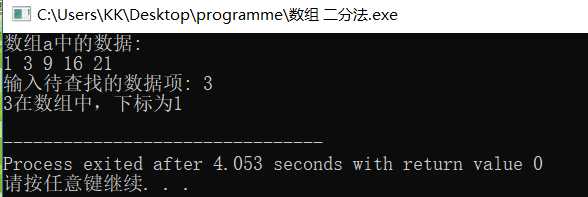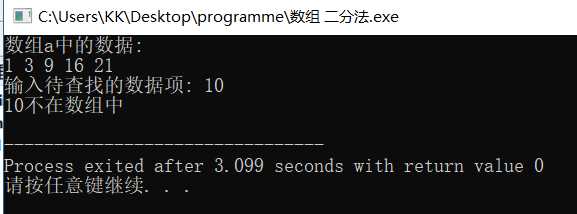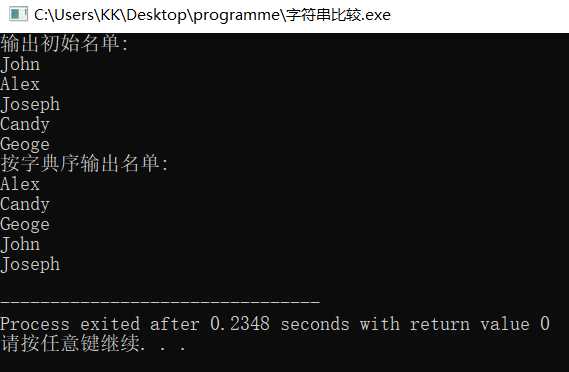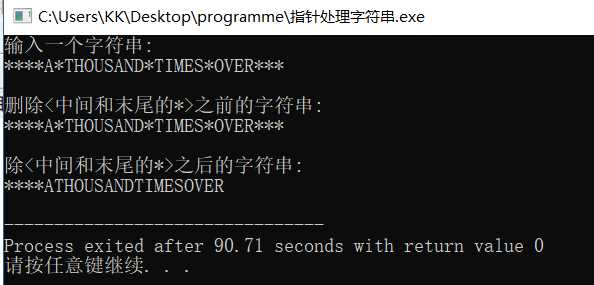标签:source 函数声明 结果 har 个数 变量 %s ret 调用函数
part.1.利用二分法查找数据
(只能查找有序数据,本代码由小到大排)
// 练习:使用二分查找,在一组有序元素中查找数据项
// 形参是数组,实参是数组名
#include <stdio.h>
const int N=5;
int binarySearch(int x[], int n, int item);
int main() {
int a[N]={1,3,9,16,21};
int i,index, key;
printf("数组a中的数据:\n");
for(i=0;i<N;i++)
printf("%d ",a[i]);
printf("\n");
printf("输入待查找的数据项: ");
/*实现方式2:形参是指针变量,实参是数组名,使用指针变量间接访问方式实现
程序源码文件*/
scanf("%d", &key);
// 调用函数binarySearch()在数组a中查找指定数据项item,并返回查找结果给index
// 补足代码①
index = binarySearch(a,N,key);
if(index>=0)
printf("%d在数组中,下标为%d\n", key, index);
else
printf("%d不在数组中\n", key);
return 0;
}
//函数功能描述:
//使用二分查找算法在数组x中查找特定值item,数组x大小为n
// 如果找到,返回其下标
// 如果没找到,返回-1
int binarySearch(int x[], int n, int item) {
int low, high, mid;
low = 0;
high = n-1;
while(low <= high) {
mid = (low+high)/2;
if (item == x[mid])
return mid;
else if(item<x[mid])
high = mid - 1;
else
low = mid + 1;
}
return -1;
}


改成指针形式
// 练习:使用二分查找,在一组有序元素中查找数据项
// 形参是指针变量,实参是数组名
#include <stdio.h>
const int N=5;
int binarySearch(int *x, int n, int item);
int main() {
int a[N]={1,3,9,16,21};
int i,index, key;
printf("数组a中的数据:\n");
for(i=0;i<N;i++)
printf("%d ",a[i]);
printf("\n");
printf("输入待查找的数据项: ");
scanf("%d", &key);
// 调用函数binarySearch()在数组a中查找指定数据项item,并返回查找结果
// 补足代码①
index=binarySearch(a,N,key);
if(index>=0)
printf("%d在数组中,下标为%d\n", key, index);
else
printf("%d不在数组中\n", key);
return 0;
}
//函数功能描述:
//使用二分查找算法在x指向的数据项开始的n个数据中,查找item
// 如果找到,返回其位置
// 如果没找到,返回-1
int binarySearch(int *x, int n, int item) {
int low, high, mid;
low = 0;
high = n-1;
while(low <= high) {
mid = (low+high)/2;
if (item == *(x+mid))
return mid;
else if(item<*(x+mid))
high = mid - 1;
else
low = mid + 1;
}
return -1;
}
part.2 选择法排序(对字符串)
选择排序法:找出数据中最小(大)元素,与起始位置交换元素;再找剩下元素中最小(大),放在已排序元素后;以此类推。
// 练习:使用选择法对字符串按字典序排序 #include <stdio.h> #include <string.h> void selectSort(char str[][20], int n ); // 函数声明,形参str是二维数组名 int main() { char name[][20] = {"John", "Alex", "Joseph", "Candy", "Geoge"}; int i; printf("输出初始名单:\n"); for(i=0; i<5; i++) printf("%s\n", name[i]); selectSort(name, 5); // 调用选择法对name数组中的字符串排序 printf("按字典序输出名单:\n"); for(i=0; i<5; i++) printf("%s\n", name[i]); return 0; } // 函数定义 // 函数功能描述:使用选择法对二维数组str中的n个字符串按字典序排序 void selectSort(char str[][20], int n) { // 补足代码 char a[1][20]; //a[0]最小 int i,j,k; for(i=0;i<n;i++){ k=j=i; strcpy(a[0],str[j]); for(;j<n;j++){ if(strcmp(a[0],str[j])>0){ strcpy(a[0],str[j]); k=j; } } strcpy(str[k],str[i]); strcpy(str[i],a[0]); } }
(注意字符串的比较与赋值分别用strcmp()和strcpy()函数。)

part.3 指针变量处理字符串练习
// 用指针变量处理字符串练习1
// 删除前导*
#include <stdio.h>
void delPrefixStar(char []); // 函数声明(函数声明中可以省略数组名不写)
int main() {
char string[80];
printf("输入一个字符串:\n");
gets(string);
printf("\n删除前导*之前的字符串:\n");
puts(string);
delPrefixStar(string);
printf("\n删除前导*之后的字符串:\n");
puts(string);
return 0;
}
// 函数定义
// 函数功能描述
// 删除字符数组s中前导*
void delPrefixStar(char s[]) {
char *target, *source;
// 从字符串开始找到不是*的位置
source = s;
while(*source == ‘*‘)
source++;
// 从这个位置开始将余下的字符前移
target = s;
while( *target++ = *source++);
}

(while( *target++= *source++)什么意思?是指*source所指的地址里没有元素停止吗)
// 用指针变量处理字符串练习2
// 删除中间和末尾的* (即除了前导*,删除字符串中其它全部*)
#include <stdio.h>
void delStarButPrefix(char []); // 函数声明(函数声明中可以省略数组名不写)
int main() {
char string[80];
printf("输入一个字符串:\n");
gets(string);
printf("\n删除<中间和末尾的*>之前的字符串:\n");
puts(string);
delStarButPrefix(string); // 调用函数,删除中间和末尾的*; 注意实参的写法
printf("\n除<中间和末尾的*>之后的字符串:\n");
puts(string);
return 0;
}
// 函数定义
// 函数功能描述
// 删除字符数组s中除了前导*以外的所有*(即删除字符串中间和末尾出现的*)
void delStarButPrefix(char s[]) {
int i=0; // i用于记录字符在字符数组s中的下标
char *p = s;
// 跳过前导*,i记录字符在字符数组s中的下标,p记录首个非*字符的位置
while(*p && *p == ‘*‘) {
p++;
i++;
}// 从p指向的字符开始,把遇到的*删除// 实现删除*的做法其实是:只有当p指向的字符不是*时,才将逐个字符复制保存在s中while(*p) {if(*p != ‘*‘) {s[i] = *p;i++;}p++;}s[i] = ‘\0‘; // 思考:这一步这样写的原因
while(*p) {
if(*p != ‘*‘) {
s[i] = *p;
i++;
}
p++;
}
s[i]=‘\0‘;
}

put()输出字符串时,检测到字符 ‘\0’ 时结束,否则一直输出。
// 用指针变量处理字符串练习3
// 删除字符串中间的*
#include <stdio.h>
void delMiddleStar(char []); // 函数声明(函数声明中可以省略数组名不写)
int main() {
char string[80];
printf("输入一个字符串:\n");
gets(string);
printf("\n删除<中间和的*>之前的字符串:\n");
puts(string);
delMiddleStar(string); // 调用函数,删除字符串中间的*; 注意实参的写法
printf("\n删除<中间的*>之后的字符串:\n");
puts(string);
return 0;
}
// 函数定义
// 函数功能描述
// 对字符数组s中存放的字符串,删除中间出现的*
void delMiddleStar(char s[]) {
int i=0;
char *tail, *head, *p;
// 找到末尾第一个非*字符的位置
tail = s;
while(*tail)
tail++;
tail--;
while(*tail == ‘*‘)
tail--;
// 找到开头第一个非*字符的位置
head = s;
while(*head == ‘*‘)
head++;
// 把中间出现的*去掉
p = s;
while(p<=head) { // 思考这里条件表达式为什么这样写,这个循环的功能?
s[i] = *p;
p++;
i++;
}
while(p<tail) {
if(*p != ‘*‘) {
s[i] = *p;i++;
}
p++;
}
while(*p) {
s[i] = *p;i++;p++;
}
s[i] = ‘\0‘; // 思考这里为什么要这样做
}

put()函数输出结尾字符必是字符‘\0‘。
总结:对于指针的编程还是不太熟悉,需要多加练习。
标签:source 函数声明 结果 har 个数 变量 %s ret 调用函数
原文地址:https://www.cnblogs.com/ability-1206/p/10922415.html